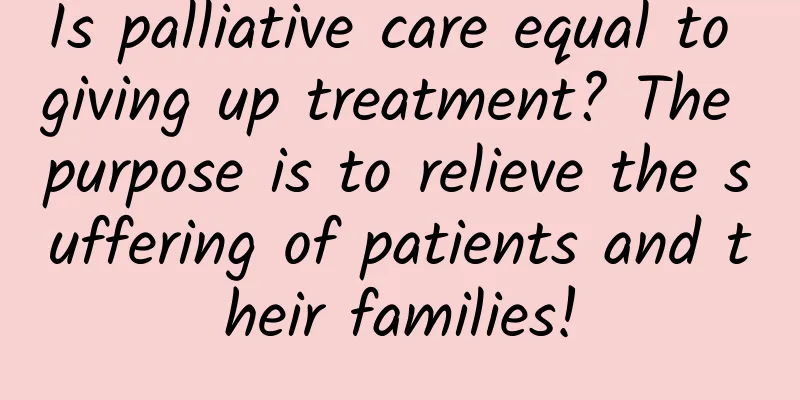Is palliative care equal to giving up treatment? The purpose is to relieve the suffering of patients and their families!

|
Author: Ning Xiaohong, Chief Physician, Peking Union Medical College Hospital Reviewer: Qu Xuan, deputy chief physician, Peking Union Medical College Hospital Palliative care is a discipline that helps patients with serious illnesses and their families relieve pain. Care for the last six months or so of life is called hospice care. Patients have disease-related pain, including chronic diseases, and need holistic care. The whole person is not just a physical person, but also includes spiritual, psychological, social and other aspects. In addition to taking care of the patient's body, we must respect the value and dignity of the person, provide psychological, social and spiritual comfort and maintenance, and help patients and their families get through difficult times together. This kind of care is called palliative care. The time limit of palliative care is very long, from the pain of the disease to death, and even to comforting the grief of the patient's family after death, all fall into the scope of palliative care. Palliative care is the care provided when there is only about six months left to live. It is the last stage of palliative care. Because people's needs are different in the period before death, including symptoms, psychological needs, and care locations. Figure 1 Original copyright image, no permission to reprint 1. What are the principles and objectives of palliative care? The purpose of palliative care is to relieve the pain of patients and their families, including caregivers. Doctors, nurses, and care workers are all caregivers, and we also hope to alleviate the pain of these people. Ultimately, we hope to improve the quality of life of patients, and hope that the quality of life will be better in the last stage of life. The relationship between palliative care and death is: it does not simply delay death, and delaying death is not the ultimate or only goal; but it will not actively accelerate the death of the patient, such as by using euthanasia. The professional palliative care team prevents and relieves physical and mental suffering through early identification, active assessment, pain control, and relief of other symptoms, both physical and psychological, in the hope of helping patients throughout their natural life cycle. Valuing life and recognizing that death is a normal process, not accelerating or delaying death, and providing ways to relieve pain and discomfort at the end of life are the core principles of palliative care. 2. What does palliative care need to know about the patient? Every patient who seeks help must be assessed to understand their current condition, where they are uncomfortable, and in what aspects they hope the palliative care team to provide help, whether it is physical, psychological, social or spiritual. Loss of appetite, pain, insomnia, dry stools, bloating, sweating, etc. are common physical pains. Psychological and spiritual levels, especially the spiritual level, for example, patients say they are afraid to sleep and feel they will not wake up once they fall asleep, which is a fear and anxiety about death. By listening to the patient, you can gradually understand his physical, psychological, social, and spiritual state and needs: ask the patient how he understands his disease, how he hopes to be treated, what effect he hopes the treatment will have, where he hopes to be cared for, whether he is willing to be hospitalized or at home, and how he views future invasive treatment measures. These are all important contents that need to be evaluated, and targeted help can be given accordingly. For example, in order to treat tumors or other diseases, the family will let the patient take chemotherapy drugs or targeted drugs, because after taking them, he will feel nausea, vomiting, loss of appetite, poor sleep, constipation...very painful. Prescribing some symptomatic drugs, such as painkillers, sleeping pills, laxatives, and drugs that promote appetite, will be of great help to him. At this moment, relieving the painful symptoms of chemotherapy is what he needs most, which means that it is particularly important to know what the patient needs. 3. What can palliative care do for terminally ill patients and their families? Making the patient comfortable and relieving his painful symptoms is the first priority. For example, if there are symptoms such as pain, loss of appetite, coughing, breathlessness, sweating, constipation, etc., drugs or non-drug methods can be used to relieve them. Figure 2 Original copyright image, no permission to reprint For example, if there is dyspnea, the first step is to find the cause of the dyspnea and treat it. Is it a lung infection, a tumor invading and compressing the trachea, or a tumor-induced pleural effusion? After analyzing and treating the above reasons, if the symptoms are not relieved satisfactorily, we must also pay special attention to the patient's emotions. Many times, anxiety and fear are also important factors that cause dyspnea. Using various methods to relieve physical and psychological pain will make him feel comfortable and sleep well. Some patients will say that they haven't had such a good sleep for a long time, and their appetite feels good and they eat more than before. After feeling comfortable, they may take the initiative to chat with their family or caregivers and communicate on the psychological and spiritual level. What we have to do is to discover the patient's pain, help resolve it, and make them as safe as possible physically, mentally and spiritually. Another thing we can do for patients is to find social resources: some patients feel that they are dying and do not want to burden others, so they do not tell their relatives and friends, and are alone, or only have their spouse to accompany them. We can ask patients who else is at home, whether they have brothers, sisters, relatives or friends. In this process, we find that there are many resources that can be mobilized, and we also find that everyone cares about him, but they just don’t know how to care for him. We will guide family members on how to accompany them; for those who have financial difficulties, we will try our best to link or introduce some available resources or ways to help patients, so as to truly provide holistic care. Another area is to help the patient's family. The pain of the family is often great. They cannot accept that the patient is going to die, they don't know what to do for the patient, whether the treatment decision is wrong, they are entangled in chemotherapy or not, whether to tell the patient the true condition, etc. Sometimes the pain of the family is not less than that of the patient himself. Figure 3 Original copyright image, no permission to reprint At this time, we should listen to and empathize with the family members, and give them support and suggestions according to their needs. For example, it is important to respect the patient's wishes regarding treatment decisions; share the stories or experiences of fellow patients, help them gradually make decisions, help the family members communicate with the patients, and even help the family members deal with the problems that bother them, such as insomnia, anxiety, fear, and collapse. We should support the family members in various ways. Because only when the family members are supported can they be able to take better care of the patients. |
>>: Will long-term consumption of MSG harm your health?
Recommend
Can I remove freckles with laser while breastfeeding?
When women are breastfeeding, they must be expose...
Delayed second menstruation after weaning
We all know that nowadays women like to breastfee...
Why do I have a dull pain in my lower abdomen half a month after giving birth?
After a long pregnancy, the baby is finally born ...
If a pregnant woman eats mangoes, will the fetus suffer from jaundice? Benefits and precautions of eating mango for pregnant women
In order to prevent the fetus from suffering from...
Can women with inflammation wear condoms during sex?
Women's physical health is very susceptible t...
Symptoms of postpartum depression in pregnant women
Pregnant women are very likely to suffer from dep...
Can the baby absorb calcium supplemented by breastfeeding mothers?
Diet and nutrition are very important for pregnan...
What should I do if I have a poor appetite during confinement?
After giving birth, many women need to stay in co...
Can spleen deficiency cause delayed menstruation?
In the field of traditional Chinese medicine, spl...
Early symptoms of uterine fibroids
Generally speaking, uterine fibroids are benign t...
How to distinguish between live frozen and dead frozen king crabs? How to cook king crabs deliciously
In recent issues, we have shared with you some co...
Blood pressure <115/75 in youth, younger brain in middle age! Australian study
Maintaining blood pressure below 115/75 mmHg star...
[Medical Q&A] Can non-invasive cardiac examination replace traditional examination methods?
Planner: Chinese Medical Association Reviewer: Fa...
Treatment for inner canthus wrinkles
Firm and translucent skin is what many mature wom...









